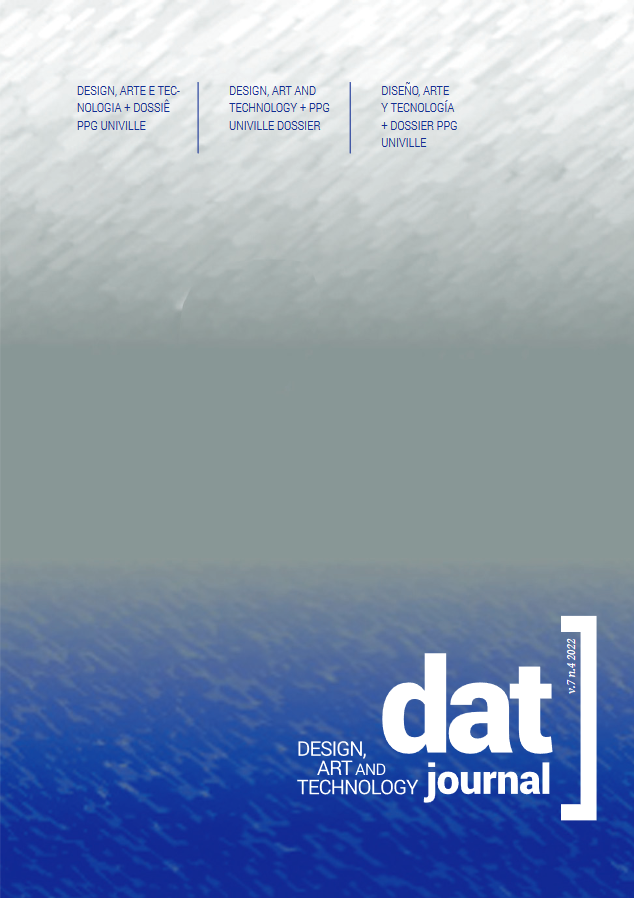Diseño centrado en el ser humano y desafíos para la interacción humano-computadora de ISO 9241-210:2019
DOI:
https://doi.org/10.29147/datjournal.v7i4.559Palabras clave:
Diseño Centrado en el Humano, interacción humano-sistema, Experiencia del usuario, Diseño UniversalResumen
ISO 9241-210:2019 representa el enfoque de diseño centrado en el ser humano de vanguardia. Este artículo presenta el resultado del análisis de los cambios en el enfoque de ISO sobre las actividades de diseño centradas en el ser humano, proporcionando subsidios para comprender los desafíos contemporáneos en el campo del diseño. En el análisis del discurso de la serie histórica – ISO 13407:1999, ISO 9241-210:2010 e ISO 9241-210:2019 –, concluimos que existe una estrecha relación entre el diseño de la interacción hombre-sistema, tal como se aborda en el documento , y , respectivamente, los principios de factores humanos/ergonomía (1999), experiencia de usuario (2010) y diseño universal (2019). Debido a los acelerados cambios sociales y ambientales y a los constantes avances tecnológicos, la norma ISO de diseño de interacción hombre-sistema debe entenderse más como una matriz que como un paradigma para proyectos que busquen alinearse con los desafíos que estarán en el punto ciego de la norma hasta el final. tu próxima actualización.
Descargas
Citas
BARANAUSKAS, M. C. C.; ROCHA, H. V. Design e Avaliação de Interfaces Humano-Computador. Campinas, SP: Univ. Est. de Campinas, 2003. Disponível em: https://www.nied.unicamp.br/biblioteca/design-e-avaliacao-de-interfaces-humano-computador/. Acesso: fev. 2021.
BENJAMIN, W. Magia e Técnica, Arte e Política. [Tradução de Paulo Sérgio Rouanet]. Obras Escolhidas; v. I. São Paulo: Brasiliense, 1987. BONSIEPE, G. Design: do material ao digital. Florianópolis: FIESC/SENAI/IEL, 1997.
BONSIEPE. Design como prática de projeto. São Paulo: Blucher, 2012.
CABRAL, A., VENTURELLI, S., & PRADO, G. (2019). Sinais detectados entre o biológico e o maquínico. DAT Journal, 4(3), 117–127. https://doi.org/10.29147/dat.v4i3.152 DOI: https://doi.org/10.29147/dat.v4i3.152
CARDOSO, R. Uma introdução à história do design. São Paulo: Edgard Blücher, 2000.
BONSIEPE. Design para um mundo complexo. Editora Ubu, 2011.
COSTA, C. “Professores da USP analisam os 100 anos da Bauhaus”. Jornal da USP. 2019. Disponível em: https://jornal.usp.br/?p=235410. Acesso: fev. 2021.
DI RUSSO, S. “Understanding the behaviour of design thinking in complex environments” (Tese). Pós-graduação em Design. Swinburne University of Technology, Melbourne, 2016.
FASTE, H. “Posthuman-Centered Design”. In: Digital Design Theory: Readings from the field. (Org.) ARMSTRONG, H. Princeton Architectural Press, New York, p. 134-137. 2016
FORLANO, L. “Posthumanism and Design”. She Ji: The Journal of Design, Economics, and Innovation, Volume 3, Issue 1, p. 16-29. 2017. DOI: https://doi.org/10.1016/j.sheji.2017.08.001
GARCIA, L. et al. “Projeto Centrado no Ser Humano: um panorama bibliométrico com base na Science Direct”. Revista Brasileira de Design da Informação. São Paulo. v. 13 n. 1. p. 39-51. 2016. DOI: https://doi.org/10.51358/id.v13i1.409
GIACOMIN, J. What is Human Centred Design? In: P&D Design 2012. 10º Congresso Brasileiro de Pesquisa e Desenvolvimento em Design, São Luís (MA), 2014.
HESKETT, J. Desenho Industrial. José Olympio; 2ª ed., 1998.
ISO 13407. Human-Centred Design process for interactive systems. Genève: ISO, 1999.
ISO 9241-11. Ergonomics of human-system interaction — Usability: Definitions and concepts. Genève: ISO, 2018.
ISO 9241-210. Ergonomics of human-system interaction — Human-centred design for interactive systems. Genève: ISO, 2010.
ISO 9241-210. Ergonomics of human-system interaction — Human-centred design for interactive systems. Genève: ISO, 2019.
ISO. Contributing to the UN Sustainable Development Goals with ISO standards. Genève: ISO, 2018.
ISO 9241-210. Contributing to the UN Sustainable Development Goals with ISO standards - Committee ISO/TC 159/SC 4 - Ergonomics of human-system interaction. Genève: ISO, 2021. Disponível em: https://www.iso.org/committee/53372.html. Acesso em 14.02.2021.
ISO 9241-210. Friendship among equals: recollections from ISO’s first fifty years. Genève: ISO, 1997.
JENKINS. H. Cultura da convergência. São Paulo: Aleph, 2009.
KRIPPENDORF, K. “Propositions of Human-centeredness: A philosophy for design.” In: DURLING, D.; FRIEDMAN, K. (Eds.) Doctoral Education in Design: Foundations for the future. Staffordshire University Press, 2000.
LÖBACH, B. Design Industrial. Bases para a configuração dos produtos industriais. 1ed. São Paulo: Edgard Blücher, 2001.
MACE, R. et. al. Accessible environment: Toward Universal Design. The Center for Universal Design. NC State University. 1991. Disponível em: https://projects.ncsu.edu/ncsu/design/cud/pubs_p/docs/ACC%20Environments.pdf. Acesso: fev.2021
MARCON, M. P., VENTURELLI, S. (2021) Apropriação das mídias sociais interativas como suporte na elaboração de contextos de aprendizagem em tempos de pandemia. DAT Journal 6(3), 39-55. HTTPS://https://doi.org/10.29147/dat.v6i3.436. DOI: https://doi.org/10.29147/dat.v6i3.436
MOZOTA, B. Design and competitive edge. London: Academic Review, Design Management Journal, 2002.
NORMAN, D. A.; DRAPER, S. W. User-centered system design: New perspectives on human-computer interaction. Hillsdale, NJ: Lawrence Erlbaum, 1986. DOI: https://doi.org/10.1201/b15703
NORMAN, D. A. O design do dia-a-dia. Anfiteatro. 2018a. E-book Kindle.
NORMAN, D. A. “The Future of Design: When you come to a fork in the road, take it”. 2018b. Disponível em: www.jnd.org/the_future_of_design_when_you_come_to_a_fork_in_ the_road_take_it Acesso: fev. 2021.
ONU. “Convention on the Rights of Persons with Disabilities”. Article 4 – General obligations. 2008. Disponível em: www.un.org/development/desa/disabilities/convention-on-the-rights-of-persons-with-disabilities/article-4-general-obligations.html. Acesso: fev. 2021.
ONU. “Transforming our world: The 2030 agenda for sustainable development.” 2015. Disponível em: www.sdgs.un.org/sites/default/files/publications/21252030%20Agenda%20for%20Sustainable%20Development%20web.pdf. Acesso: fev. 2021.
PREECE, J. et. al. Design de Interação: Além da Interação Humano-Computador. Porto Alegre: Bookman, 2005.
ROSA, et. al. Neurodesign - O cérebro e a máquina. Rio de Janeiro, RJ: Rio Book’s, 2016.
STEPHANIDIS, C. et. al. Seven HCI Grand Challenges, International Journal of Human-Computer Interaction, 35:14, p. 1229-1269. 2019. DOI: https://doi.org/10.1080/10447318.2019.1619259
Descargas
Publicado
Cómo citar
Número
Sección
Licencia
Derechos de autor 2022 DAT Journal

Esta obra está bajo una licencia internacional Creative Commons Atribución 4.0.


























